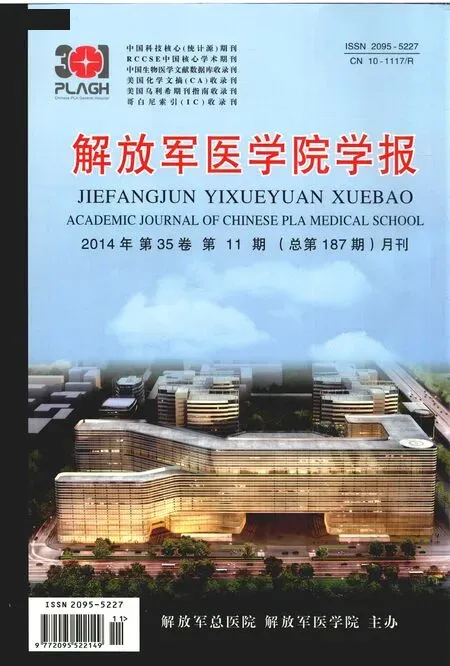胰十二指肠切除术后胰瘘发生的相关因素
刘其雨,李 立,夏红天,张文智,蔡守旺,刘志伟,冷建军昆明市第一人民医院 肝胆外科,云南昆明 65003;解放军总医院 肝胆外科,北京 00853
胰十二指肠切除术后胰瘘发生的相关因素
刘其雨1,李 立1,夏红天2,张文智2,蔡守旺2,刘志伟2,冷建军2
1昆明市第一人民医院 肝胆外科,云南昆明 650031;2解放军总医院 肝胆外科,北京 100853
目的探讨胰十二指肠切除术后胰瘘的发生情况及相关因素分析。方法回顾性分析解放军总医院2013年1 - 12月完成的196例胰十二指肠切除术临床资料,并对围术期可能与胰瘘发生相关的因素进行单因素分析和Logistic回归多因素分析。结果196例胰十二指肠切除术后发生A级胰瘘62例(31.6%),B级胰瘘53例(27.0%),C级胰瘘11例(5.6%),总体胰瘘发生率高达64.3%,有临床意义的胰瘘(即B、C级胰瘘)64例,占32.7%。经单变量及多变量回归分析发现,胰管直径≤3 mm是总体胰瘘发生的独立风险因素,胰管直径≤3 mm和胰液内引流是有临床意义的胰瘘发生的独立风险因素。结论胰瘘仍然是胰十二指肠切除术后早期主要并发症,胰管直径≤3 mm是胰瘘发生的主要独立风险因素,胰液引流至体外可以降低临床胰瘘的发病率并减轻胰瘘的严重程度。
胰十二指肠切除术;胰瘘;并发症;胰管
胰十二指肠切除术是治疗壶腹癌、胰头癌、胆总管下段癌的标准手术方案,但胰瘘仍然是其术后主要并发症之一,也是影响其近期预后的主要因素,发病率为12.1% ~ 44.7%[1-4]。本文通过回顾性分析解放军总医院2013年196例胰十二指肠切除术的相关临床资料,进一步论证胰瘘的发生情况,并对其相关因素进行分析。
资料和方法
1 一般资料 2013年1 - 12月解放军总医院共完成196例胰十二指肠切除术,其中男性122例,女性74例,男女比例为1.6∶1,年龄(57.0±11.5)岁。原发病主要包括Vater壶腹癌60例,胆管下段癌48例,胰头癌35例,胰头交界性肿瘤23例,十二指肠恶性肿瘤13例,慢性炎症11例,钩突部肿瘤6例。首发症状主要有黄疸、腹胀不适、腹痛、发热、贫血。25例通过体检发现病变。壶腹周围癌主要以黄疸为主,胰头交界性肿瘤及钩突部肿瘤多无明显临床症状,而十二指肠癌多以贫血或消化道出血就诊。本组病人主要合并高血压(59例)及糖尿病(31例),二者均合并的19例。
2 手术方案 196例胰十二指肠切除术中的消化道重建顺序均采用胰肠吻合、胆肠吻合、胃(或十二指肠)肠吻合,其中胰肠吻合、胆肠吻合均采用结肠后位,而胃(或十二指肠)肠吻合采用结肠前位。不同的是,导管对黏膜的胰肠吻合178例,套入式胰肠吻合18例;胰液外引流61例,胰液内引流135例;保留幽门90例,不保留幽门106例;采用布朗吻合40例,未采用布朗吻合156例。
3 胰瘘判定 严格按照2005年国际胰瘘研究小组的胰瘘定义[5]。需要强调的是,原文中明确指出胰十二指肠切除术后第3天或术后3 d后的任何一天的可计量容积的引流液淀粉酶超过正常血清淀粉酶上限3倍即为胰瘘,而非术后某固定的一天,亦未定义引流量超过50 ml/d,本组病人手术3 d后均被常规监测引流液淀粉酶,直至出院。术后出现的感染征象包括发热、白细胞增高、CRP升高等,排除其他原因感染的,但又未进行侵入性干预治疗的归为B级,而采取侵入性治疗手段的则归为C级。其中B、C级胰瘘定义为临床胰瘘(clinically relevant pancreatic fistula,CRPF)。
4 统计学处理 采用SPSS19.0统计软件分析,数据采用±s表示,P<0.05为差异有统计学意义。单变量分析根据情况采用χ2检验和Fisher's精确概率检验。将上述有统计学意义的变量再引入Logistic回归模型进行多因素分析,选入变量的检验水准为0.05。
结 果
1 胰瘘发生率及住院情况 196例胰十二指肠切除术后发生A级胰瘘62例(31.6%),B级胰瘘53例(27.0%),C级胰瘘11例(5.6%),总体胰瘘共发生率为64.3%,临床胰瘘64例,占32.7%。死亡3例(1.5%),均为胰瘘后并发假性动脉瘤破裂出血引起的多脏器功能衰竭。总住院时间为(29±12.1) d,术后住院时间为(19.7±11.2) d。
2 胰瘘的单因素及多因素分析 性别、年龄、体质量指数(body mass index,BMI)、合并高血压、合并糖尿病、术前血CA19-9水平、黄疸、血清白蛋白、手术出血量、胰管直径、是否保留幽门、胰液引流方式、胰肠吻合方式13个变量中仅有胰管直径与胰瘘发生有关,胰管直径、胰液引流方式与临床胰瘘发生有关,而其他11个变量均与胰瘘(包括临床胰瘘)发生无关(表1)。经Logistic回归进行多变量分析后发现,胰管直径≤3 mm是胰十二指肠切除术后发生胰瘘的独立风险因素,胰管直径≤3 mm和胰液内引流是临床胰瘘发生的独立风险因素,其中胰管直径≤3 mm同时是胰瘘和临床胰瘘的独立风险因素。见表2。

表1 影响胰十二指肠切除术后胰瘘发生的单因素分析Tab. 1 Univariate analysis of predictors for pancreatic fistula following pancreaticoduodenectomy (n)

表2 影响胰十二指肠切除术后胰瘘发生的Logistic回归分析Tab. 2 Logistic regression for predictors of pancreatic fistula following pancreaticoduodenectomy
讨 论
胰十二指肠切除术后发生胰瘘一直是学者们的研究热点,胰瘘的定义亦有很多种类[6-8]。2005年国际胰瘘研究小组对胰瘘的定义已被越来越多的人认可。但在实际中仍然有很多统计不能严格按照该标准,这在某种程度上影响了不同中心研究结果的对比。
本研究发现,胰十二指肠切除术后胰瘘主要与胰管直径有关,直径≤3 mm的胰管术后更易发生胰瘘,而与性别、年龄、BMI、合并高血压、合并糖尿病、术前血CA19-9水平、黄疸、血清白蛋白、手术出血量、是否保留幽门、胰肠吻合方式等无关[9-11]。主要因为扩张的胰管多伴有胰腺纤维化,甚至胰腺萎缩,且扩张的胰管更易吻合。此外,通过胰管支撑管将胰液引流至体外,减少胰液的渗漏量,进一步减少胰液蛋白酶的激活,以此减轻胰瘘的严重程度,可明显降低术后临床胰瘘的发病率。本研究亦证实胰液内引流是临床胰瘘的独立风险因素。
胰腺残端的吻合方式一直是争论的焦点,但目前越来越多的人采用胰管对空肠黏膜吻合,以保证黏膜对黏膜的生长。Binziad等[12]通过前瞻性研究将胰肠吻合术分为胰管对空肠黏膜吻合、套入式及胰胃吻合3组,发现胰管对空肠黏膜吻合更少引起胰瘘[12-13]。<3 mm的胰管进行胰肠吻合,需要精湛的显微外科技术,建议使用6-0或7-0 PDS-Ⅱ缝线,动作轻柔,避免暴力牵拉。也有学者提出黏膜无缝线的胰空肠吻合方式[14-15]。
临床胰瘘引起的假性动脉瘤破裂出血是胰十二指肠切除术后短期内的主要死亡原因。本研究中3例死亡均是该原因。因此临床胰瘘的早期诊断和及时干预显得尤为重要,一旦怀疑胰瘘,首选腹部B超、CT进一步明确,并可在其引导下进行腹腔穿刺引流,以免造成更严重的后果[16-19]。
1 Peng F, Wang M, Zhu F, et al. “Total arterial devascularization first” technique for resection of pancreatic head cancer during pancreaticoduodenectomy[J]. J Huazhong Univ Sci Technolog Med Sci, 2013, 33(5):687-691.
2 Sugimoto M, Takahashi S, Gotohda N, et al. Schematic pancreatic configuration: a risk assessment for postoperative pancreatic fistula after pancreaticoduodenectomy[J]. J Gastrointest Surg, 2013, 17(10): 1744-1751.
3 El Nakeeb A, Salah T, Sultan A, et al. Pancreatic anastomotic leakage after pancreaticoduodenectomy. Risk factors, clinical predictors, and management (single center experience)[J]. World J Surg, 2013, 37(6):1405-1418.
4 Kimura W, Miyata H, Gotoh M, et al. A pancreaticoduodenectomy risk model derived from 8575 cases from a National Single-Race population (Japanese) using a Web-Based data entry system the 30-Day and in-hospital mortality rates for pancreaticoduodenectomy[J]. Ann Surg, 2014, 259(4): 773-780.
5 Bassi C, Dervenis C, Butturini G, et al. Postoperative pancreatic fistula: an international study group (ISGPF) definition[J]. Surgery, 2005, 138(1): 8-13.
6 Xie YB, Wang CF, Zhao DB, et al. Risk factors associated with postoperative hospital stay after pancreaticoduodenectomy: a retrospective study[J]. Chin Med J (Engl), 2013, 126(19):3685-3689.
7 Miller BC, Christein JD, Behrman SW, et al. A multi-institutional external validation of the fistula risk score for pancreatoduodenectomy[J]. J Gastrointest Surg, 2014, 18(1): 172-179.
8 Roberts KJ, Hodson J, Mehrzad H, et al. A preoperative predictive score of pancreatic fistula following pancreatoduodenectomy[J]. HPB (Oxford), 2014, 16(7):620-628.
9 Ke S, Ding XM, Gao J, et al. A prospective, randomized trial of Roux-en-Y Reconstruction with isolated pancreatic drainage versus conventional loop Reconstruction after pancreaticoduodenectomy[J]. Surgery, 2013, 153(6): 743-752.
10 Yanagimoto H, Satoi S, Yamamoto T, et al. Clinical impact of preoperative cholangitis after biliary drainage in patients who undergo pancreaticoduodenectomy on postoperative pancreatic fistula[J]. Am Surg, 2014, 80(1): 36-42.
11 Su AP, Zhang Y, Ke NW, et al. Triple-layer duct-to-mucosa pancreaticojejunostomy with resection of jejunal serosa decreased pancreatic fistula after pancreaticoduodenectomy[J]. J Surg Res,2014, 186(1):184-191.
12 Binziad S, Salem AA, Amira G, et al. Impact of reconstruction methods and pathological factors on survival after pancreaticoduodenectomy[J]. South Asian J Cancer, 2013, 2(3):160-168.
13 Haane C, Mardin WA, Schmitz B, et al. Pancreatoduodenectomy--current status of surgical and perioperative techniques in Germany [J]. Langenbecks Arch Surg, 2013, 398(8): 1097-1105.
14 Ishizaki Y, Yoshimoto J, Sugo H, et al. Validation of mucosal sutureless pancreatojejunostomy after pancreatoduodenectomy[J]. Am Surg, 2014, 80(2):149-154.
15 Neychev VK, Sladinger PF. Minimizing shear and compressive stress during pancreaticojejunostomy rationale of a new technical modification[J]. JAMA Surg, 2014, 149(2): 203-207.
16 Raman SP, Horton KM, Cameron JL, et al. CT after pancreaticoduodenectomy: spectrum of normal findings and complications[J]. AJR Am J Roentgenol, 2013, 201(1): 2-13.
17 Robinson K, Rajebi MR, Zimmerman N, et al. Postpancreaticoduodenectomy hemorrhage of unusual origin: treatment with endovascular embolization and the value of preoperative CT angiography[J]. J Radiol Case Rep, 2013, 7(4): 29-36.
18 Wellner UF, Kulemann B, Lapshyn H, et al. Postpancreatectomy hemorrhage--incidence, treatment, and risk factors in over 1,000 pancreatic resections[J]. J Gastrointest Surg, 2014, 18(3):464-475.
19 张小英,吕发勤,唐杰.影像学在胰腺创伤诊治中的应用进展[J].解放军医学院学报,2013,34(12):1285-1288.
Prognostic factors for pancreatic fistula following pancreaticoduodenectomy
LIU Qi-yu1, LI Li1, XIA Hong-tian2, ZHANG Wen-zhi2, CAI Shou-wang2, LIU Zhi-wei2, LENG Jian-jun2
1Department of Hepatobiliary Surgery, First People's Hospital of Kunming, Kunming 650031, Yunnan Province, China;2Department of Hepatobiliary Surgery, Chinese PLA General Hospital, Beijing 100853, China
XIA Hong-tian. Email: Xiahongtian115@sina.com
ObjectiveTo explore the morbidity and prognostic factors of postoperative pancreatic fistula (POPF) following pancreaticoduodenectomy (PD).MethodsClinical data about 196 consecutive patients who underwent PD in Chinese PLA General Hospital from January 1, 2013 to December 31, 2013 were recorded retrospectively. Univariate analysis and multivariate logistic regression analysis were used to estimate relative risks.ResultsOf the 196 patients, POPF of grade A occurred in 62 patients (31.6%), grade B in 53 patients (27.0%), grade C in 11 cases (5.6%), with a total incidence of 64.3% (126/196) and the incidence of clinically relevant POPF (CR-POPF) was 32.7% (64/196). Univariate analysis and multivariate regression analysis showed that pancreatic duct diameter and POPF rates were significantly correlated, pancreatic duct diameter≤3 mm was an independent risk factor for POPF. The CR-POPF rate was higher in patients without external pancreatic stent, furthermore, it was also an independent risk factor for CR-POPF.ConclusionPOPF contributes to early postoperative morbidity and pancreatic duct diameter≤3 mm is an independent risk factor of POPF. The external drainage of pancreatic secretion with an external stent across pancreaticojejunal anastomosis can significantly reduce the mortality of CR-POPF and alleviate the severity of POPF.
pancreaticoduodenectomy; pancreatic fistula; complication; pancreatic duct
R 735.9
A
2095-5227(2014)11-1109-04
10.3969/j.issn.2095-5227.2014.11.008
时间:2014-07-16 11:02 网络出版地址:http://www.cnki.net/kcms/detail/11.3275.R.20140716.1102.002.html
2014-05-26
刘其雨,男,博士,主治医师。专业方向:肝胆外科基础与临床研究。2013年7月- 2014年7月在解放军总医院肝胆外科进修。Email: liuqiyu_12@hotmail.com
夏红天,男,博士,副主任医师。Email: Xiahongtian1 15@sina.com

